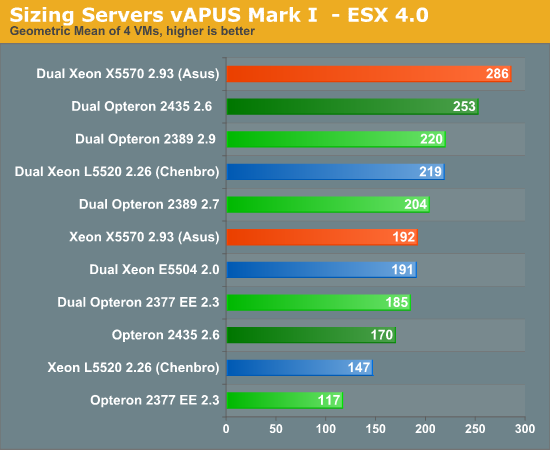Testing the latest x86 rack servers and low power server CPUs
by Johan De Gelas on July 22, 2009 2:00 AM EST- Posted in
- IT Computing
Performance: Low Power CPUs Compared
The differences in performance are small, even insignificant, between the different servers. When it comes to comparing the servers, we'll focus on power consumption. When it comes to performance, we'll focus on the CPUs. We use our vApus Mark I benchmark as it has a mix of decision support (MS SQL Server), OLTP (Oracle), and web serving (PHP, IIS) on top of VMware's ESX 4.0. You can read a detailed description of our in-house developed benchmark here. We are working on an open source version to allow third parties to repeat our benchmarking.
We ran vApus mark I with one tile. Normally you'll see at least two tile (8 VMs) benchmarks in our server CPU tests unless we are limited by memory. As the amount of registered DDR3 memory available to us is at present 12 4GB DIMMs (48GB) and we had to fill a 4-server node Twin2 machine, we were limited to 12GB per node. Therefore, all testing is done with one tile or four VMs.

There's lots of interesting data here for the hardware loving professionals. It is the first time we have done such extensive testing on ESX 4.0, and we notice that while the Xeon X5570 and "Istanbul" Opteron 2435 are in line with our previous review, the quad-core "Shanghai" Opteron numbers are not (+6%). As in the previous review most of our attention was on the new AMD hex-core and its Xeon X5570 rival, so we did not double-check our Opteron 2384 numbers. If you compare them with our ESX 3.5 numbers, you'll see that quad-core Opteron is about 6% faster with ESX 4.0, while its six-core brother does not gain anything. As we use four vCPUs per VM, it is a lot harder for the ESX scheduler to do this efficiently on the six-core chip and that is most likely the reason why hex-core does not benefit from the ESX 3.5 to ESX 4.0 update.
Also interesting is that the Xeon "Nehalem" at 2.26GHz is capable of keeping up with the 2.9GHz Opteron "Shanghai". Remember, vAPUS Mark I is one of the benchmarks where AMD is at its best. In this best case for AMD, the Nehalem architecture is about 28% faster clock for clock. The Xeon E5504, the second slowest available Xeon "Nehalem", does not have Hyper-Threading (lose about 15%) or turbo boost (another ~5% loss) and only has 4MB of L3 cache. The result is that it is only 15% faster clock for clock than the Shanghai Opteron.
Also noteworthy is that one Xeon 2.93GHz performs as well as a dual Xeon at 2GHz and slightly better than a dual Opteron 2377 EE. If we tested with eight VMs, the dual machines would perform slightly better, while the single CPU system would stagnate. Still, that does not change the fact that a single socket server with a Xeon X5570 might be an interesting alternative to many dual socket servers if performance/watt matters.
Our performance conclusion is that the best Opteron EE is about as fast as the Xeon Nehalem at 2GHz. The L5520, Intel's lowest power "Nehalem" is as fast as the fastest 75W ACP Opteron at 2.9GHz. Next up are the power consumption numbers.










12 Comments
View All Comments
Photubias - Wednesday, July 22, 2009 - link
VMware recognizes the problem as being a reporting issue between the BIOS and ESX. It should be fixed by U1 of ESX4.More info here.
Photubias - Wednesday, July 22, 2009 - link
This is the correct link:http://kb.vmware.com/selfservice/microsites/search...">http://kb.vmware.com/selfservice/micros...=3100028...